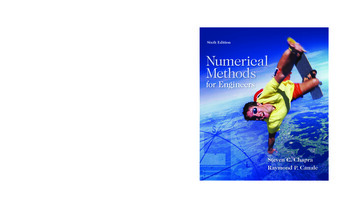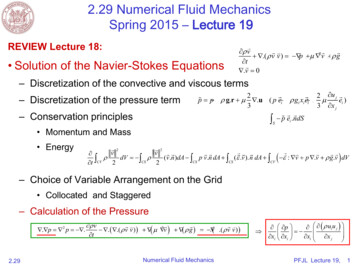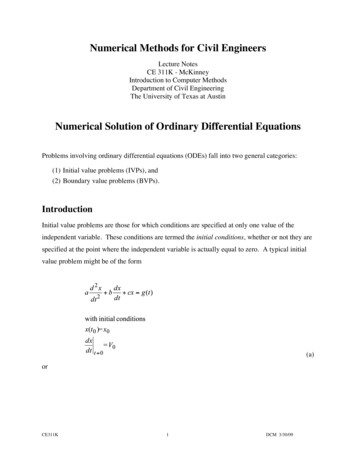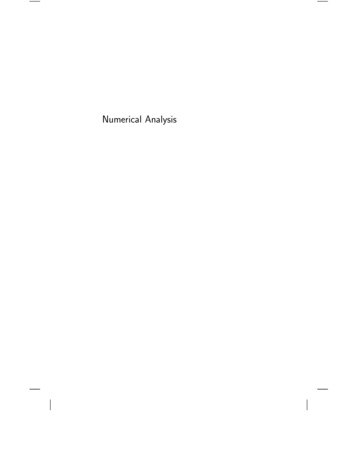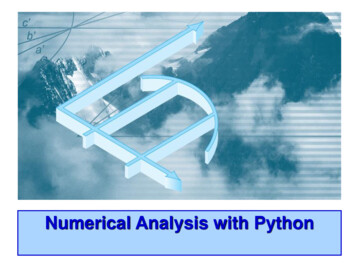
Transcription
Lecture Notes on Numerical Methodsfor Engineering (?)Pedro Fortuny AyusoU NIVERSIDAD DE O VIEDOE-mail address: fortunypedro@uniovi.es
CC BY:Copyright c 2011–2016 Pedro Fortuny AyusoThis work is licensed under the Creative Commons Attribution 3.0License. To view a copy of this license, /or send a letter to Creative Commons, 444 Castro Street, Suite 900,Mountain View, California, 94041, USA.
ContentsIntroduction1. Some minor comments55Chapter 1. Arithmetic and error analysis1. Exponential notation2. Error, basic definitions3. Bounding the error771016Chapter 2. Numerical Solutions to Non-linear Equations1. Introduction2. The Bisection Algorithm3. Newton-Raphson’s Algorithm4. The Secant Algorithm5. Fixed Points6. Annex: Matlab/Octave Code19192022242632Chapter 3. Numerical Solutions to Linear Systems of Equations1. Gauss’ Algorithm and LU Factorization2. Condition Number: behavior of the relative error3. Fixed Point Algorithms4. Annex: Matlab/Octave Code3535404446Chapter 4. Interpolation1. Linear (piecewise) interpolation2. Can parabolas be used for this?3. Cubic Splines: Continuous Curvature4. The Lagrange Interpolating Polynomial5. Approximate Interpolation6. Code for some of the Algorithms49495051576064Chapter 5. Numerical Differentiation and Integration1. Numerical Differentiation2. Numerical Integration—Quadrature Formulas696971Chapter 6. Differential Equations1. Introduction79793
4CONTENTS2.3.4.5.6.7.8.The BasicsDiscretizationSources of error: truncation and roundingQuadratures and IntegrationEuler’s Method: Integrate Using the Left EndpointModified Euler: the Midpoint RuleHeun’s Method: the Trapezoidal Rule81828586868789Chapter 7. Multivariate and higher order ODEs1. A two-variable example2. Multivariate equations: Euler and Heun’s methods3. From greater order to order one93939698
IntroductionThese notes cover what is taught in the classes of Numerical Methods for Engineering in the School at Mieres. One should not expectmore than that: a revision of what has been or will be explained during the course. For a more correct, deep and thorough explanation,one should go to the material referenced in the bibliography?Simply, statedThese notes are no substitute for a book (ortwo).and even moreWhat is here may and may not covercompletely the contents of the exam1. Some minor commentsMy aim in these notes is mostly twofold: To introduce the basic problems tackled by Numerical Calculus in their most simple fashion. To get the students used to stating algorithms with precisionand to understanding the idea of complexity.I also would like to be able to make the students aware of the importance of the conditioning of a numerical problem and the need toverify that the results obtained by a computer program match realityand fit the problem under study. But there is really no space (muchless time in the course) for this.We shall refer, along the way, to several computing tools. Specifically,Matlab: I shall try to make all the code in this notes runnableon Octave but this text will only speak of Matlab, which isthe software students are used to working with at Mieres.Wolfram Alpha: This is a powerful and very useful tool withwhich a large number of operations (mathematical and not)can be performed, on a simple web page.5There is none.
6INTRODUCTIONWhat may be most interesting is that the students can: State algorithms with precision, aware that an algorithm mustbe clear, finite and finish. Follow the steps of an algorithm and roughly analyze itscomplexity (or at least, compare two of them).I would also like to stress the importance of discerning if an approach suits a specific problem or not depending on its good or badconditioning but, alas, there is also too little time in the course. . .It goes without saying that they will have to understand and beable to follow, step by step, the algorithms stated in the classes (thisis an essential requisite). All the algorithms that will be explained areof easy memorization because they are either brief (most of them) orgeometrically elemental (so that their verbal expression is easily toremember). Formal precision is much more important in this coursethan geometric ideas because numerical analysis deals with formalmethods of solving specific problems, not with their geometrical orintuitive expression. This is the main rub of this course. You willneed to memorize.
CHAPTER 1Arithmetic and error analysisExponential notations, double precision floating point, the notion of error and some common sources of error in computations aresummarily reviewed. The student should at least get a feeling ofthe importance of normalization of floating point arithmetic and thatmistakes in its use can be critical.1. Exponential notationReal numbers can have a finite or infinite number of digits. Whenworking with them they have to be approximated using a finite (andusually small) number of digits. Even more, they should be expressed in a standard way so that their magnitude and significantdigits are easily noticed at first sight and so that sharing them amongmachines is a deterministic and efficient process. These requirements have led to what is known as scientific or exponential notation. We shall explain it roughly; what we intend is to transmit theunderlying idea more than to detail all the rules (they have lots ofparticularities and exceptions). We shall use, along these notes, thefollowing expressions:D EFINITION 1. An exponential notation of a real number is an expression of the form A.B 10C10C A.B A.BeCwhere A, B and C are natural numbers (possibly 0), is a sign (whichmay be elided if ). Any of those expressions refers to the real number ( A 0.B) · 10C (where 0.B is “nought dot B. . . ”).For example: The number 3.123 is the same 3.123. The number 0.01e 7 is 0.000000001 (eight zeroes after thedot and before the 1).7
81. ARITHMETIC AND ERROR ANALYSIS The number 103 2.3 is 2300. The number 23.783e 1 is 2.3783.In general, scientific notation assumes the number to the left of thedecimal point is a single non-zero digit:D EFINITION 2. The standard exponential notation is the exponentialnotation in which A is between 1 and 9.Finally, machines usually store real numbers in a very specificway called floating point.D EFINITION 3. A floating point format is a specification of an exponential notation in which the length of A plus the length of B isconstant and in which the exponents (the number C) vary in a specific range.Thus, a floating point format can only express a finite amount ofnumbers (those which can be written following the specifications ofthe format).The blueprint for the floating point standard for microchips (andfor electronic devices in general) is document IEEE-754 (read “I-Ecube seven-five-four”). The acronym stands for “Institute of Electrical and Electronic Engineers”. The last version of the documentdates from 2008.1.1. The binary double precision format of IEEE-754. The double precision format is the IEEE specification for representing realnumbers in sequences of 16, 32, 64, 128 bits (and more cases) andtheir decimal representation. The main properties of binary doubleprecision with 64 bits are roughly explained in this section.In order to write numbers in double precision, 64 bits are used,that is, 64 binary digits. The first one stands for the sign (a 0 means , a 1 means ). The 11 following ones are used for the exponent(as will be shown) and the remaining 52 are used for what is calledthe mantissa. Thus, a double precision number has three parts: s, thesign, which can be 0 or 1; e, the exponent, which varies between 0and 211 1 2047; and m, a 52-bit number. Given three values fors, e and m, the real number represented by them is: If e 6 0 and e 6 2047 (i.e. if the exponent is not one of theend values), thenN ( 1)s 2e 1023 1.m,where 1.m means “one-dot-m” in binary. Notice —and thisis the key— that the exponent is not the number represented by
1. EXPONENTIAL NOTATION9the 11 bits of e but that it is “shifted to the right”. The exponent e 01010101011, which in decimal is 683 represents,in double precision format, the number 2683 1023 2 340 .Those e with a starting 0 bit correspond to negative powersof 2 and those having a starting 1 bit to positive powers (recall that 210 1024). If e 0 then, if m 6 0 (if there is a mantissa):N ( 1)s 2 1023 0.m,where 0.m means “zero-dot-m” in binary. If e 0 and m 0, the number is either 0 or 0, depending on the sign s. This means that 0 has a sign in doubleprecision arithmetic (which makes sense for technical reasons). The case e 2047 (when all the eleven digits of e are 1) isreserved for encoding “exceptions” like and NaN (nota-number-s). We shall not enter into details.As a matter of fact, the standard is much longer and thorough andincludes a long list of requisites for electronic devices working infloating point (for example, it specifies how truncations of the mainmathematical operations have to be performed to ensure exactnessof the results whenever possible).The main advantage of floating point (and of double precisionspecifically) is, apart from standardization, that it enables computingwith very small and very large numbers with a single format (thesmallest storable number is 2 1023 ' 10 300 and the largest one is21023 ' 10300 ). The trade off is that if one works simultaneously withboth types of quantities, the first lose precision and tend to disappear(a truncation error takes place). However, used carefully, it is a hugelyuseful and versatile format.1.2. Binary to decimal (and back) conversion. ? In this course,it is essential to be able to convert a number from binary to decimalrepresentation and back.In these notes, we shall use the following notation: the expression x a means that x is a variable, a is a value (so that it can bea number or another variable) and that x gets assigned the value ofa. The expression u c is the conditional statement “the value designed by u is the same as that designed by c”, which can be eithertrue or false. We also denote m//n as the quotient of dividing thenatural number m 0 by the natural number n 0, and m%n is theExamples?
101. ARITHMETIC AND ERROR ANALYSISremainder of that division. That is,m (m//n) n (m%n).Finally, if x is a real number x A.B, the expression { x } means thefractional part of x, i.e., the number 0.B.E XAMPLE 1. The following table shows the decimal and binaryexpansions of several numbers. The last binary expansion is approximate because it has an infinite number of 1 0.000110011 Algorithm 1 (in page 11) is a way to convert a decimal numberA.B with a finite number of digits to its binary form. Algorithm 2performs the reverse conversion. Notice that, as there are numberswith a finite quantity of decimal digits which cannot be expressedwith a finite quantity of binary digits (the most obvious examplebeing 0.1), one has to specify a number of fractional digits for theoutput (which implies that one does not necessarily obtain the verysame number but a truncation).Converting from binary to decimal is “simpler” but requires additions on the go: one does not obtain a digit at each step becauseone has to add powers of two. This process is described in Algorithm2. Notice that the number of digits of the output is not specified (itcould be done but it would only make the algorithm more complex).Finally, in all those steps in which Ai 2i or Bi 2 i is added, bothAi and Bi are either 0 or 1, so that this multiplication just means “either add or do not add” the corresponding power of 2 (this is what abinary digit means, anyway).2. Error, basic definitionsWhenever numbers with a finite quantity of digits are used incomputations and whenever real measurements are performed, onehas to acknowledge that errors will be made. This is not grave by itself. What matters is having an estimate of their size and knowing that,as calculations are made, they can propagate. In the end, the bestone can do is to bound the absolute error, that is, to know a reasonable
2. ERROR, BASIC DEFINITIONS11Algorithm 1 Conversion from decimal to binary, without sign.Input: A.B a number in base 10, with B of finite length, k a positiveinteger (which is the desired number of fractional digits after thebinary dot)Output: a.b (the number x in binary format, truncated to 2 k )if A 0 thena 0 and go to the F RACTIONAL PARTend if? I NTEGRAL PARTi 1, n Awhile n 0 doi i 1xi n%2 [remainder]n n//2 [quotient]end whilea xi xi 1 . . . x0 [the sequence of remainders in reverseorder]? F RACTIONAL PARTif B 0 thenb 0return a.bend ifi 0, n 0.Bwhile n 0 and i k doi i 1m 2nif m 1 thenbi 1elsebi 0end ifn {m} [the fractional part of m]end whileb b1 b2 . . . bireturn a.bvalue (the bound) which is larger than the error, in order to assess,with certainty, how far the real value can be from the computed one.In what follows, an exact value x is assumed (a constant, a datum,the exact solution to a problem. . . ) and an approximation will bedenoted x̃.
121. ARITHMETIC AND ERROR ANALYSISAlgorithm 2 Conversion from binary to decimal, without sign.Input: A.B, a number in binary format, k a non-negative integer(the number of the fractional binary digits to be used).Output: a.b, the decimal expression of the truncation up to precision 2 k of the number A.B? I NTEGRAL PARTWrite A Ar Ar 1 . . . A0 (the binary digits)a 0, i 0while i r doa a A i 2ii i 1end while? F RACTIONAL PARTif B 0 thenreturn a.0end ifb 0, i 0while i k doi i 1b b Bi 2 iend whilereturn a.bD EFINITION 4. The absolute error incurred when using x̃ insteadof x is the absolute value of their difference x x̃ .But, unless x is 0, one is usually more interested in the order ofmagnitude of the error; that is, “how relatively large the error is” ascompared to the real quantity.D EFINITION 5. The relative error incurred when using x̃ insteadof x, assuming x 6 0, is the quotient x̃ x x (which is always positive).We are not going to use a specific notation for them (some peopleuse and δ, respectively).E XAMPLE 2. The constant π, which is the ratio between the lengthof the circumference and its diameter, is, approximately 3.1415926534 (the trailing indicates that the real number is larger than the representation). Assume one uses the approximation π̃ 3.14. Then
2. ERROR, BASIC DEFINITIONS13 The absolute error is π π̃ 0.0015926534 .π̃ The relative error is π ' 10 4 5.069573.πThis last statement means that one is incurring an error of 5 tenthousandths per unit (approx. 1/2000) each time 3.14 is used for π.Thus, if one adds 3.14 two thousand times, the error incurred whenusing this quantity instead of 2000 π will be approximately π. Thisis the meaning of the relative error: its reciprocal is the number oftimes one has to add x̃ in order to get an accrued error equal to thenumber being approximated.Before proceeding with the analysis of errors, let us define thetwo most common ways of approximating numbers using a finitequantity of digits: truncation and rounding. The precise definitionsare too detailed for us to give. Start with a real number (with possibly an infinite quantity of digits):x a 1 a 2 . . . a r . a r 1 . . . a n . . .notice that there are r digits to the left of the decimal point. Define:D EFINITION 6. The truncation of x to k (significant) digits is: the number a1 a2 . . . ak 0 . . . 0 (an integer with r digits), if k r, the number a1 . . . ar .ar 1 . . . ak if k r.That is, one just cuts (i.e. truncates) the numerical expression of x andadds zeroes to the right if the decimal part has not been reached.D EFINITION 7. The rounding of x to k (significant) digits is thefollowing number: If ak 1 5, then the rounding is the same as the truncation. If 5 ak 1 9, then the rounding is the truncation plus10r k 1 .Remark: the rounding described here is called biased to plus infinitybecause when the k 1 th digit is greater than or equal to 5, theapproximation is always greater than the true value.The problem with rounding is that all the digits of the rounded number can be different from the original value (think of 0.9999 roundedto 3 significant digits). The great advantage is that the error incurredwhen rounding is less than the one incurred when truncating (it caneven be a half of it):
141. ARITHMETIC AND ERROR ANALYSISE XAMPLE 3. If x 178.299 and one needs 4 significant1 figures,then the truncation is x1 178.2, whereas the rounding is 178.3. Theabsolute error in the former case is 0.099, while it is 0.001 in the latter.E XAMPLE 4. If x 999.995 and 5 digits are being used, the truncation is x1 999.99, while the rounding is 1000.0. Even though allthe digits are different the absolute error incurred in both cases is thesame: 0.005. This is what matters, not that the digits “match”.Why is then truncation important if rounding is always at leastas precise and half the time better? Because when using floatingpoint, one cannot prevent truncation from happening and it must betaken into account to bound the global error. As of today (2013) mostof the computer programs working in double precision, performtheir computations internally with many more digits and round theirresults to double precision. However, truncations always happen(there is a limited amount of available digits to the processor).2.1. Sources of error. Error appears in different ways. On onehand, any measurement is subject to it (this why any measuring device is sold with an estimated margin of precision); this is intrinsicto Nature and one can only take it into account and try to assessits magnitude (give a bound). On the other hand, computations performed in finite precision arithmetic both propagate these errors andgive rise to new ones precisely because the quantity of available digits is finite.The following are some of the sources of error: Measurement error, already mentioned. This is unavoidable. Truncation error: happens whenever a number (datum or theresult of a computation) has more digits than available andsome of them must be “forgotten”. Rounding error: takes place when a number is rounded to aspecified precision. Loss of significance (also called cancellation error): this appearswhen an operation on two numbers increases relative errorsubstantially more than the absolute error. For example,when numbers of very similar magnitude are subtracted.The digits lost to truncation or rounding are too relevant andthe relative error is huge. A classical example is the instability of the solution of the quadratic equation.1We have not explained the meaning of this term, but we shall not do so.Suffice it to say that “significant figures” means “exact figures” in an expression.
2. ERROR, BASIC DEFINITIONS15 Accumulation error: which appears when accumulating (withadditions, essentially) small errors of the same sign a lot oftimes. This is what happened with the Patriot Missile Stations in 1991, during the Desert Storm operation2.All the above errors may take place when working with finite arithmetic. The following rules (which describe the worst-case behaviors)apply: When adding numbers of the same sign, the absolute error canbe up to the sum of the absolute errors and the same canhappen to the relative error. When adding numbers of different sign, the absolute error behaves like in the previous case but the relative error may behavewildly: 1000.2 1000.1 has only a significant digit, so that therelative error can be up to 10%, but the relative error in theoperands was at most 1 10 4 . When multiplying, the absolute error is of the same magnitude as the largest factor times the absolute error in the otherfactor. If both factors are of the same magnitude, the absolute error can be up to double the maximum absolute errortimes the maximum factor. The relative error is of the samemagnitude as the maximum relative error in the factors (andis the sum if both factors are of the same magnitude). When dividing by a number greater than or equal to 1, the absolute error is approximately the absolute error in the numerator divided by the denominator and the relative erroris the relative error in the numerator (more or less like inmultiplication). When dividing by numbers near 0, absoluteprecision is lost and later operations with numbers of thesame magnitude will probably give rise to large cancellationerrors. Example 5 is illustrative of this fact: the first line isassumed to be an exact computation, the second one an approximation using a truncation to 6 significant figures in thedivisor of the quotient. One can see that the “approximation” is totally useless.An example of the bad behavior of division and addition is thefollowing:2One can read a summary athttp://www.cs.utexas.edu/ downing/papers/PatriotA1992.pdfand the official report is also 026.htm.
161. ARITHMETIC AND ERROR ANALYSISE XAMPLE 5. Consider the following two computations, the firstone is assumed to be “correct” while the second one is an approximation:33 0.256 (the exact result) .0.00124563326493 8.2488 (approximation)0.00124626493 The relative error in the rounding of the denominator is only 3 10 4 (less than half a thousandth of a unit), but the relative error inthe final result is 33.2 (which means that the obtained result is 33times larger in absolute value than it should, so it is worthless asan “approximation”). Notice that not even the sign is correct. Thisis (essentially) the main problem of resolution methods involvingdivisions (like Gauss’ and, obviously, Cramer’s). When explainingGauss’ method, convenient ways to choose an adequate denominator will be shown (these are called pivoting strategies). As a generalrule, the larger the denominator, the better.3. Bounding the errorAs we have already said, one does not seek an exact knowledgeof the error incurred during a measurement or the solution to a problem, as this will likely be impossible. Rather, one aims to have an ideaof it and, especially, to know a good bound of it. That is, to be able toassess the maximum value that the absolute error can take and thisbeing a useful piece of information. Knowing that 2.71 is an approximation of e with an error less than 400 is worthless. Knowing thatthe error is less than 0.01 is useful.In general, the only possibility is to estimate a reasonably smallnumber larger than the incurred error. This is bounding the error.3.1. Some bounds. If one knows that a quantity is between twovalues, which is usually expressed in the form x a e for somee 0, then the absolute error incurred when using a instead of x isunknown but is bounded by e. So that the relative error is, at most, thise divided by the smallest of the possible absolute values of x. Noticethat this is tricky because if a e 0 and a e 0 then there is noway to bound the relative error because x can be 0 and then there is norelative error (it is not defined for x 0).
3. BOUNDING THE ERROR17E XAMPLE 6. If π 3.14 0.01, then the maximum absolute errorincurred is 0.01, so that the relative error is at most0.01' .003194 3.13 (more or less 1/300).Notice that in order to get an upper bound of a quotient, the denominator must be bounded from below (the lesser the denominator, thegreater the quotient).The rules in page 15 are essential in order to bound the error ofa sequence of arithmetic operations. One has to be especially carefulwhen dividing by numbers less than one, as this may lead to uselessresults like “the result is 7 with a relative error of 23.”
CHAPTER 2Numerical Solutions to Non-linear EquationsThe problem of solving the non-linear equation f ( x ) 0 given fand some initial conditions is treated in this chapter.Each of the algorithms which will be explained in this chapterhas its own advantages and disadvantages; one should not discardanyone a priori just for its “slowness” —for example, bisection. Weshall see that the “best” one —namely, Newton-Raphson’s— has twodrawbacks: it may converge far from the initial condition, becominguseless for finding a root “near” a specific point and it requires thecomputation of the value of the derivative of f at each step, whichmay be too costly.Notice that all the algorithms we present include stopping conditions which depend on the value of f ( x ) and are of Cauchy-type.This is done in order to simplify the exposition. If a specific quantity of exact figures is required, one needs to perform a much deeperstudy of the problem being solved, of the derivative of f and otherelements, which are out of the scope of these notes.1. IntroductionComputing roots of functions, and especially of polynomials, isone of the classical problems of Mathematics. It used to be believedthat any polynomial could be “explicitly solved” like the quadraticequation, via a formula involving radicals (roots of numbers). GaloisTheory, developed in the beginning of the XIX Century, proved thatthis is not the case at all and that, as a matter of fact, most polynomials of degree greater than 4 are not solvable using radicals.However, the search for a closed formula for solving equations isjust a way of putting off the real problem. In the end, and this iswhat matters:The only computations that can always be performed exactly are addition,subtraction and multiplication.19
202. NUMERICAL SOLUTIONS TO NON-LINEAR EQUATIONSIt is not even possible to divide and get exact results1.From the beginning, people sought ways to quickly find approximate solutions to nonlinear equations involving the four rules: addition, subtraction, multiplication and division.Two different kind of algorithms are explained in this chapter:those with a geometric meaning and the fixed point method, whichrequires the notion of contractivity.Before proceeding, let us remark two essential requirements inany root-computing algorithm: The specification of a precision, that is an e 0 such that if f (c) e, then c is taken as an approximate root of f . This isneeded because, as non-exact computations are performed,expecting a result f (c) 0 is unrealistic, so that this equalityis useless as a stopping condition. A second stopping condition unrelated to the value of f . Itmay well happen that either the algorithm does not converge or that f has no roots, so that the statement f (c) eis never true. In any case, the algorithm must finish at somepoint. Otherwise, it is not an algorithm. This implies the needfor a condition unrelated to f . This takes usually the form“perform no more than n steps,” where n is a counter.2. The Bisection AlgorithmAssume f is a continuous function on a closed interval [ a, b].Bolzano’s Theorem may be useful if its conditions hold:T HEOREM (Bolzano). Let f : [ a, b] R be a continuous function on[ a, b] such that f ( a) f (b) 0 (i.e. it changes sign between a and b). Thenthere is c ( a, b) with f (c) 0.This statement asserts that if the sign of f changes on [ a, b] thenthere is at least a root of f in it. One could sample the interval usingsmall sub-intervals (say of width (b a)/10i ) and seek, among thissub-intervals, one where the sign changes, thus nearing a root at eachstep. Actually, dividing the interval into two segments turns out tobe much simpler.Start with a function f , continuous on the interval [ a, b] with values f ( a) and f (b). Specify a desired precision e 0 (so that if1One could argue that using rational numbers solves this problem but, again,there is a point at which decimal expansions are needed.
2. THE BISECTION ALGORITHM21 f (c) e then c is accepted as an approximate root) and a maximum number of iterations N 0 of the process. With all these data,one proceeds taking advantage of Bolzano’s Theorem, as follows:If f ( a) f (b) 0, then there is a root in ( a, b). Take c as the mida bpoint2 of the interval, that is c . There are three possibilities2now: Either f (c) e and one takes c as an approximate root andfinishes the algorithm. Or f ( a) f (c) 0 and one substitutes c for b and repeats. Or f (c) f (b) 0 and one substitutes c for a and repeats.The iteration is done at most N times (so that one obviously has tokeep track of their number). If after N iterations no approximate roothas been found, the process ends with an error message.The formal statement of the process just described is Algorithm3. Notice that the expression a b is used, meaning that a takes (oris given) the value b.E XAMPLE 7. Take the function f ( x ) cos(e x ), which is continuous in the interval [0, 1]. Obviously, f (0) f (1) 0 (why is this obvious?), so that Bolzano’s Theorem applies. Setting a 0, b 1,Algorithm 3 gives the following sequence: each assignment to a or bmeans that the corresponding endpoint of the interval is substitutedfor that value.octave Bisec(@(x) cos(exp(x)), 0, 1, .001, 10)c 0.50000b 0.50000% new interval: [0, 0.50000]c 0.25000a 0.25000% new interval: [0.25000, 0.50000]c 0.37500a 0.37500% new interval: [0.37500, 0.50000]c 0.43750a 0.43750% new interval: [0.43750, 0.50000]c 0.46875b 0.46875% new interval: [0.43750, 0.46875]c 0.45312b 0.45312% new interval: [0.43750, 0.45312]c 0.44531a 0.44531% new interval: [0.44531, 0.45312]c 0.44922a 0.44922% new interval: [0.44922, 0.45312]c 0.45117octave f(c) ans 6.4520e-042This is what gives the algorithm the alternative name “midpoint rule.”
222. NUMERICAL SOLUTIONS TO NON-LINEAR EQUATIONSAlgorithm 3 Bisection Algorithm.Input: A function f ( x ), a pair of real numbers a, b with f ( a) f (b) 0, a tolerance e 0 and a limit of iterations N 0Output: either an error message or a real number c between a andb such that
3. Cubic Splines: Continuous Curvature 51 4. The Lagrange Interpolating Polynomial 57 5. Approximate Interpolation 60 6. Code for some of the Algorithms 64 Chapter 5. Numerical Differentiation and Integration 69 1. Numerical Differentiation 69 2. Numerical Integration—Quadrature Formulas 71 Chapter 6. Differential Equations 79 1. Introduction .

